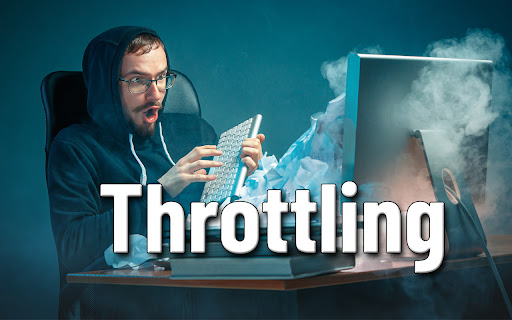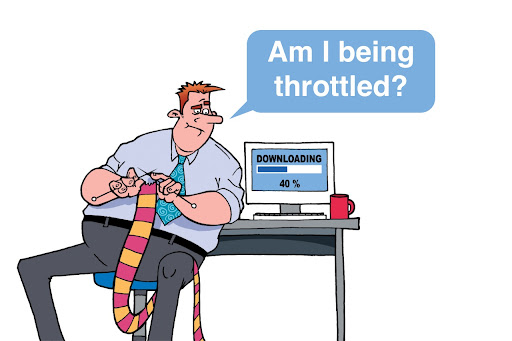What is Throttling, and how to avoid it?
Teethecutecat - Jan 12, 2023

Let's look at the leading causes of lags on personal computers and smartphones and how to avoid them.
Table of Contents
"Throttling" is a term often seen in various computer hardware reviews. However, it is widespread processor protection, not a scary word or a severe problem.
All owners of smartphones, tablets, laptops or PCs have faced this phenomenon more than once. It can happen while playing the best slots or live roulette in online casinos for Indian and while watching a movie from a PC or smartphone. But what does this process mean? How does it appear, and is it worth turning it off? Nevertheless, it is what we will deal with.

What is called throttling?
Throttling is protecting the processor from overheating. When the processor reaches a critical temperature, the system resets clock frequencies, i.e. forcibly reduces performance to allow the processor to cool down. In front of us, trivial foolproof protection keeps the components from burning up.
Computer or laptop processors can boast a long lifespan. Their lifespan often reaches ten years, compared to drives and video processors. Smartphones are different. Some CPUs can work freely at 60-70 degrees, and some start to drop frequencies already at 50 degrees.
How does throttling manifest itself?
As you have already understood, throttling is a forced reduction of performance to avoid overheating. From this, you will notice:
- Unexpected "lags.";
- Your game or other heavy application will start to lag, and the system, in general, will freeze;
- Unexpected frequency reset;
- Excessive fan noise.
It is also possible to trigger this throttling manually through a program. First, go to the official site of AIDA64. Download the latest version of the program - the service is paid, but there is a trial period of 30 days. This time is enough to run all the necessary tests. First, we will do a CPU stress test to see the temperature at 100% load.
The dangers of overheating
We have already mentioned that the higher the processor load is, the higher the temperature is. If you don't keep an eye on this indicator and constantly overload your system, your CPU will start overheating. How is this dangerous? First of all, excessively high temperatures are detrimental to any computing component. With prolonged peak loads, you run the risk of significantly reducing the performance and operational life of the system. In other words, soon, you risk going to the store to buy a new processor.
Protection triggering temperature
On CPUs, the critical temperature at which throttling activates can vary. For example, Intel processors can operate at 100 degrees; at a higher level, the forced decrease in performance will begin. And on the Pentium 4 Northwood, this process will start at 82-85 degrees.
Can you disable throttling?
Yes, you can, but disabling the throttling may have disastrous consequences. First, it is a safety measure to prevent the "melting of the iron". It was invented because no developer wants to make excuses for millions of burnt kernels later. They must constantly think about the perfect balance between reliability and high performance.
Nowadays, all processors include a unique technology for auto overclocking. So if, for example, the CPU runs typically at about 3 GHz, overclocking can put the pedal to the floor and overclock to 4.5 GHz. But, unfortunately, it will also increase the temperature, which will trigger throttling when it reaches a critical point.
By turning off this protection, you take a risk and are ready to say goodbye to your processor. Of course, you can not worry about it if the cooling system and power supply unit are fully operational without heavy loads. But you should agree that it is almost impossible to foresee it! So we are sitting, playing some heavy game, and after a while - the sudden shutdown of the computer from the molten processor. That's why we highly recommend that you don't disable protection.
If you deactivate throttling, enter BIOS and look for the tab with processor parameters. You can not altogether disable the protection, but you can increase the critical temperature.
Prevention of Throttling on Smartphones and PCs, or How to avoid overheating
So, we have already discovered that "throttling" is not a scary word but a banal protection against overheating. On smartphones, computers and laptops, it manifests itself in different ways. Below we suggest exploring how you can avoid overheating and reduced frequencies. At the same time, we will answer a popular question - CPU throttling, what to do?
On smartphones and tablets
There is no way to avoid throttling on smartphones or tablets with flagship chipsets, such as the Snapdragon 800 series, Kirin 900, Exynos 8900 and 9800. Moreover, the process is inevitable! Why? They are designed to operate at the maximum of their capabilities. Yes, it's short-lived, but what a performance! You can do nothing if the phone suddenly stops sluggish in some game. Just wait for the processor to cool down.
Modern smartphones usually have an optimally tuned processor. And here, you can already work with the frequencies. However, suppose your phone has no other cooling system; then, by turning off the throttling. In that case, you will notice a rapid discharge of the battery and just a scorching back panel. With constant loads and overheating after a while, you will have to change your smartphone or tablet.

On computers and laptops
Desktop computers rarely encounter throttling. And all thanks to an impressive power supply that allows you to install an efficient cooling system. Suppose you notice that the PC began to falter and slow down in those games that previously did not. If the processor refuses to work in turbo mode, the coolers are howling at full speed, and the temperature is going off the scale, then it is a direct way to diagnose. Use the program AIDA64 and the instruction described above. Observe the operation of the processor.
A dry thermal paste or a dusty radiator is the main reason for such failures or protection triggering. Yes, usually, a simple dust cleaning is enough. Although it may also be a faulty cooling system: it may be time to change the coolers. You can also remove the side panel of the system unit so that the PC can breathe better.
Removing the back panel for better cooling is no longer possible in a laptop. Playing with modern toys at high settings, remember to monitor the temperature from time to time. It is essential to maintain the optimum value; otherwise, overheating will affect the processor and other (adjacent) components. After all, in such a small box, there is little room to breathe.
Featured Stories

Review - Aug 23, 2025
Revolutionize Your Communication: How to Buy Virtual Numbers on Telegram

Review - Jun 25, 2025
Windows 11 Problems: Is Microsoft's "Best" OS Actually Getting Worse?

Features - Jun 18, 2025
Best Mobile VPN Apps for Gaming 2025: Complete Guide

Review - Jun 18, 2025
Nintendo Switch 2 Review: A Triumphant Evolution Worth the Wait

Mobile - Jun 12, 2025
Best Gaming Phones 2025: Top Devices for Mobile Gaming

Mobile - Jun 12, 2025
Vivo T4 Ultra Debuts with MediaTek Dimensity 9300+ Chipset

Gadgets - Jun 12, 2025
Lava Prowatch Xtreme Launches with Google Fit Integration

Mobile - Jun 08, 2025
Realme GT 7T Review: Power Meets Endurance in Controversial Style

Mobile - Jun 07, 2025
Realme C73 5G Launches in India: Budget 5G Phone Starts at ₹10,499

Review - Jun 07, 2025
Comments
Sort by Newest | Popular